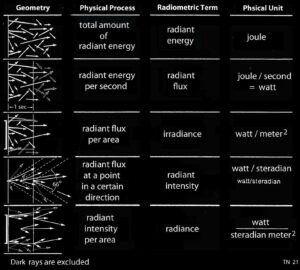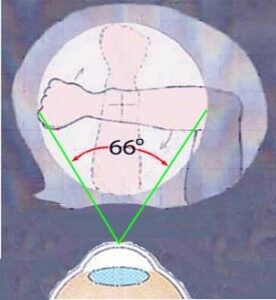Main Body
20 MEASURING PHOTONS
There are two main types of electromagnetic measurements:
RADIOMETRIC – concern physical energy
PHOTOMETRIC- translate that energy in terms of its wavelengths’ effectiveness for vision based on the above CIE relative sensitivity standards (pages 51 & 52)
The measurement principles are the same for both types of measurement. Each has its own terms for the same method of measurement.
Radiometric units are based on the joule – the standard unit for defining energy.
Illumination engineers, architects, and vision researchers are unlikely to use these measurements – unless working on applications such as green houses, certain manufacturing processes, and certain medical aspects of radiation. Even so, they are worth a look, because they represent the physical basis of the photometric measurements..
Radiometric Units p. 75
These diagrams portray photons in various ways that they can be captured for measurement.29 
While shown being emitted from a source on the left, these concepts and terms apply equally to radiation being received at a surface – just reverse the direction of the arrows.
p.76
Total radiant energy can be a critical factor for certain chemical reactions.
Flux describes the rate at which the radiant energy is emitted or received. The effectiveness of various radiation sources is characterized by how much flux they emit. Ongoing processes such as photo-electric reactions depend on the rate at which radiation is received.
Irradiance Whether that radiation is spread over a broad area or concentrated is likely to matter more than the total rate for processes occurring within a certain area. It tends to be used more with respect to being received than emitted.
Radiant Intensity takes into account the directionality of the radiant flux. This is necessary when the radiation is focused to efficiently apply it to a particular location. The steradian is the unit for measuring the three- dimensional specificity of direction – further explained below.
Radiance is the amount of radiant intensity emitted per unit area of a source, or received per unit area. Most sources of radiation are not point sources, therefore their effectiveness is better described by how much directional flux they emit per unit area. This applies equally to the effectiveness of radiation received per unit area of a sensor.
p. 77
We tend to think of direction as linear, but being infinitely thin, pure direction lacks enough reality to actually contain any energy. A steradian is the physical measurement of direction – a 3-dimensional solid angle.

The solid angle in steradians of a cone-like space with an open surface area, S, at any distance, r, from the origin is the ratio of that area divided by the surface’s distance:
steradian = S / r2
For a circular cone, 1 steradian always subtends a plane angle of 66 degrees.
(Steradians can have any shape as long as they comply with the above formula.)
p. 78
Compared to the unit for measuring plane angles, the degree, the steradian is quite large and difficult to visualize.

This may help:
- Extend your arm straight out from one eye and close the other eye.
- Bend the forearm 90 degrees.
- Make a fist.
- Focus on the forearm’s mid-point.
- Swing the forearm in a circle around that mid-point as much as possible perpendicular to your line of sight.
The circle described by your knuckle and inside of the elbow is about the size of a steradian.
